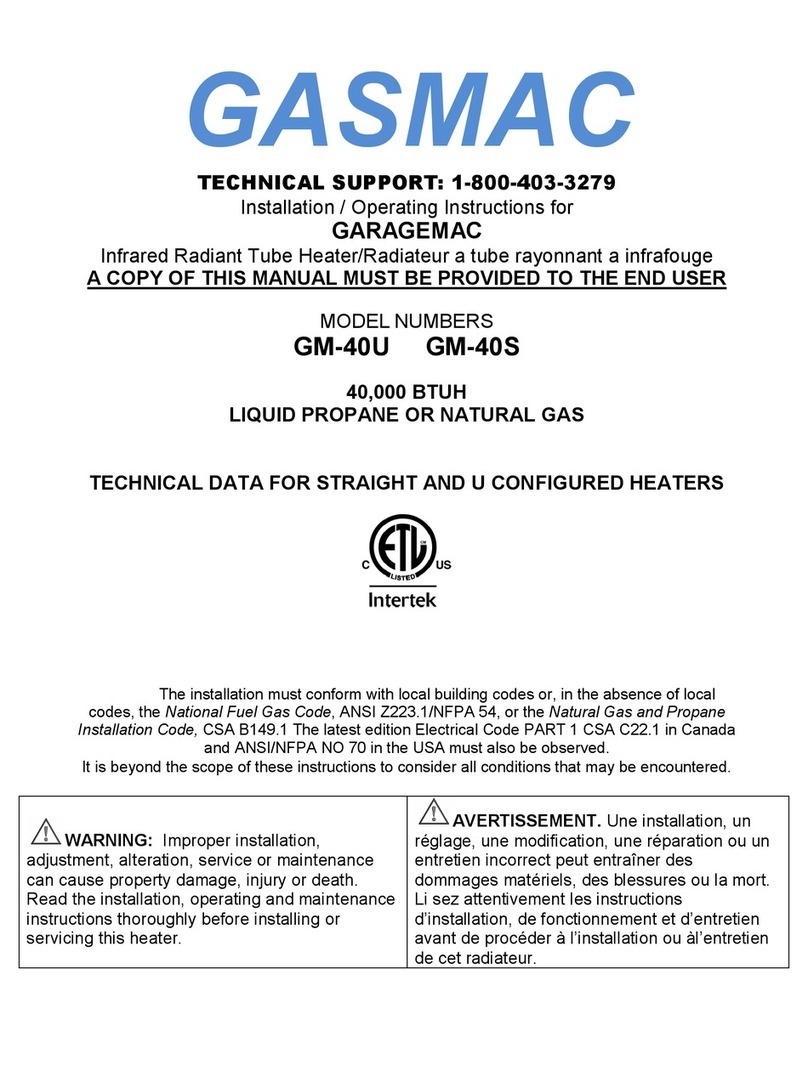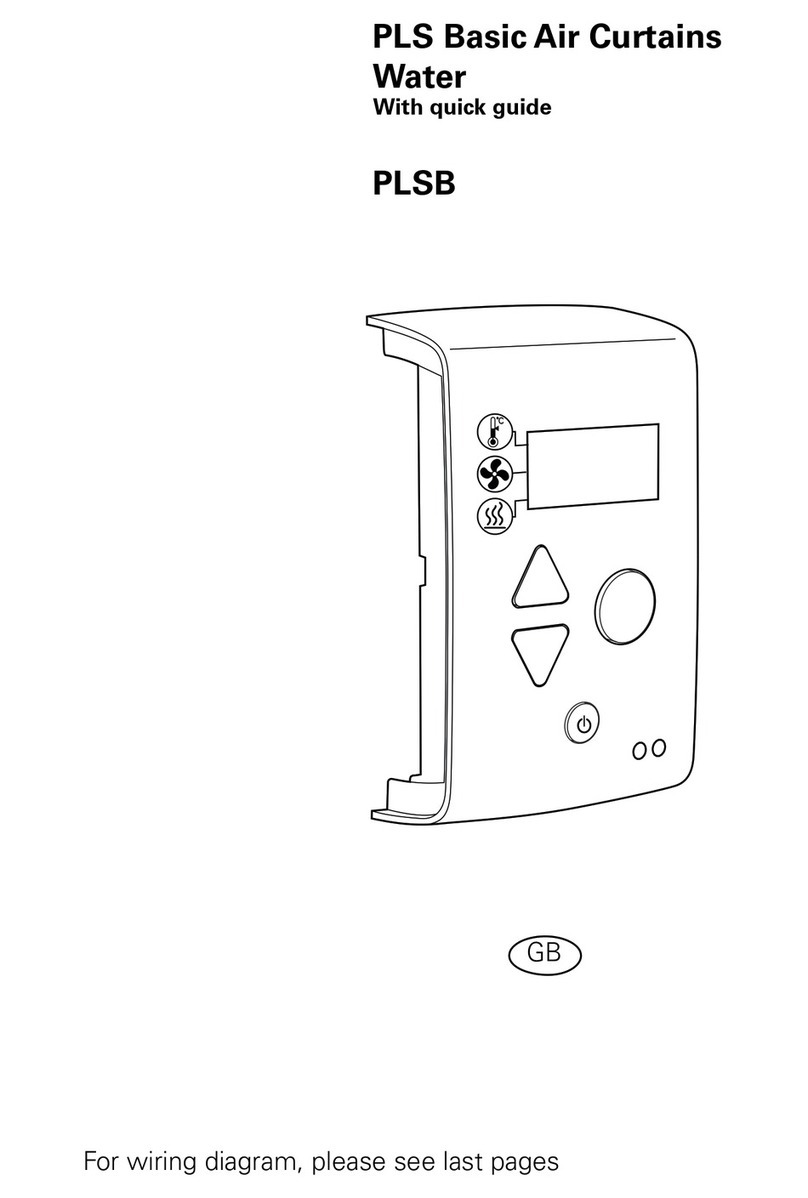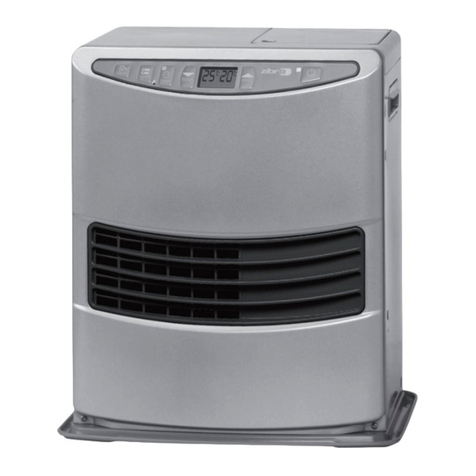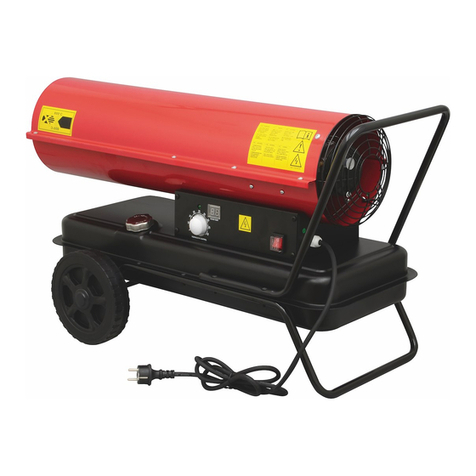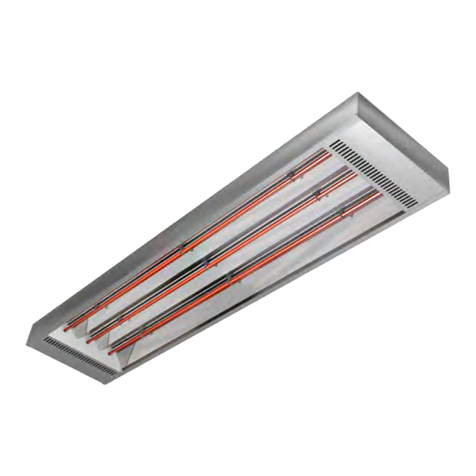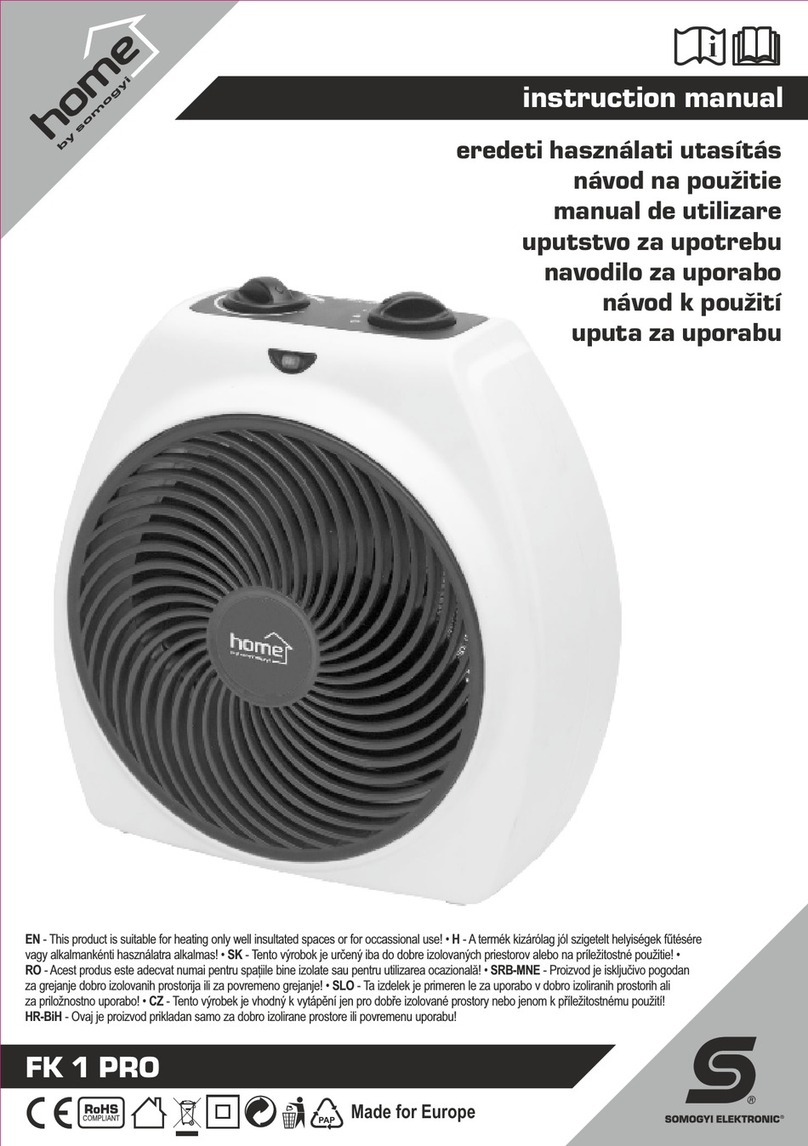Gasmac RW-60-20 User manual

12288 Brawn Side Rd. 22, Wainfleet, Ontario, Canada L0S 1V0
Phone 905-899-3473 e-mail erw@vaxxine.com Fax 905-899-2262
Installation / Operating Instructions for
Infrared Radiant Tube Heater
MODEL NUMBERS
(GM)RW-60-20 (GM)RW-135-50 (GMU)RWU-60-10 (GMU)RWU-135-30
(GM)RW-75-20 (GM)RW-150-40 (GMU)RWU-75-10 (GMU)RWU-150-20
(GM)RW-80-20 (GM)RW-150-50 (GMU)RWU-80-10 (GMU)RWU-150-25
(GM)RW-85-30 (GM)RW-160-40 (GMU)RWU-85-15 (GMU)RWU-150-30
(GM)RW-100-30 (GM)RW-165-50 (GMU)RWU-100-15 (GMU)RWU-160-20
(GM)RW-100-40 (GM)RW-165-60 (GMU)RWU-100-20 (GMU)RWU-165-25
(GM)RW-125-30 (GM)RW-200-60 (GMU)RWU-125-15 (GMU)RWU-165-30
(GM)RW-125-40 (GM)RW-200-70 (GMU)RWU-125-20 (GMU)RWU-200-30
(GM)RW-125-50 (GMU)RWU-125-30 (GMU)RWU-200-35
Technical Data GM, GMU, RW& RWU straight and U shape radiant tube heaters.
Adding the letter B to the prefix indicates a brooder model.
Adding the suffix LTHindicates dual input with the low input being 70% of the high input.
Adding the suffix CWindicates a car wash heater.
The installation must comply with local codes and CAN / CGA B – 149 in Canada
or the National Fuel Gas codes
This appliance has been tested and approved in accordance with
ANSI Z 83.20 / CSA 2.34 (2008) and ANSI Z83.20A / CSA 2.34 (2010) and CAN/CGA 21.7 .M91
for gas burning appliances.
WARNING: Improper installation,
adjustment, alteration, service or
maintenance can cause property damage,
injury or death. Read the installation,
operating and maintenance instructions
thoroughly before installing or servicing
this equipment.
AVERTISSEMENT. Une installation, un
réglage, une modification, une réparation ou un
entretien incorrect peut entraîner des dommages
matériels, des blessures ou la mort. Li sez
attentivement les instructions d’installation, de
fonctionnement et d’entretien avant de procéder
à l’installation ou àl’entretien de cet
équipement.

2
FOR YOUR SAFETY
IF YOUSMELL GAS Consignes De Securite
SI VOUS SENTEZ UNE ODEUR DE GAZ
1. Open windows 1. Ouvrez les fenetres
2. Do not touch electrical switches, or telephone 2. Ne touchez pas aux interrupteurs electriques
3. Extinguish any open flame 3. Eteignez toute flamme nue
4. Immediately call your fuel supplier 4. Contactez immediatement compagnie de gaz
5. If your gas supplier is not available, call the fire
department 5. Si votre fournisseur de gaz n’est pas disponible,
appeler les pompiers.
6. Do not attempt to light this or any other appliance 6. Ne pas tenter d’allumer ceci ou aucun autre
appareil.
This appliance has been tested and approved in accordance with
ANSI Z83.20 / CSA 2.34 (2008) and ANSI Z83.20A / CSA 2.34 (2010) and
CAN/CGA 21.7 .M91
For Indoor Installation only. Not for use in residential dwellings
Installation a l’interieur seulement. Ne pas installer dans un logement.
Gas Supply Natural
Gas Propane Electrical
Manifold Pressure 3.5” W.C. 10.0” W.C. 120 volts 60Hz
Min. Inlet Pressure 7.0” W.C. 11.5” W.C. Starting Current 3 amps
Max. Inlet Pressure 14.0” W.C. 14.0” W.C. Running Current 1 amp
Max. Outlet Pressure 3.5” W.C. 10.0” W.C. Thermostat Control 120V (Standard)
Gas Connection ½ in. N.P.T. 24V (optional)
Combustion Air Inlet 4” O.D. Ignition System 120 volts Hot Surface Ignition
Vent Connection 4” O.D. (glow bar)

3
CLEARANCES TO COMBUSTIBLES
The clearance to combustible materials represents the minimum distance that must be maintained
between the heater and a nearby surface.
The stated clearance to combustibles represents a surface temperature of 90 degree Fahrenheit
(32 degrees Celsius) above room temperature. Building material with a low heat tolerance may
be subject to degradation of lower temperatures. It is the installer’s responsibility to assure that
adjacent material are not subject to degradation.
A warning statement that an overhead heater should be installed so that the minimum clearances
marked on the heater will be maintained from vehicles parked below the heater.
Minimum clearances (inches) from combustibles measured from radiant surface.
Clearances are reduced by 1/3, 15 ft (4.6 meters) from the burner.
For installation at elevations above 2000 ft (610m), the appliance shall be de-rated 4 percent for
each 1000 ft (305m) of elevation above sea level.
30DEG.
MAX
30DEG.
MAX
BELOW
ABOVE
ABOVE
ABOVE
ABOVE
BELOW
SIDE
SIDE
SIDE
SIDE
BACK
SIDE
SIDE
BACK
BELOW
BELOW
Minimum Clearances to Combustibles/ Escape Libre Minimum Entres Les
Materiaux Combustibles
HORIZONTAL/HORIZONTALE 30 DEG.ANGLE
Above/Sommet
Below/Dessous
Side/Cote
Back/Dos

4
CLEARANCES TO COMBUSTIBLES
Model Length Input (BTU) Hangers Weight Clearance to Combustibles (inches)
ft .
Approx
lbs
Approx
BELOW SIDES TOP BACK(45 DEGREES)
GM(RW)60-20 21’8” 60,000 4 91 48 25 4 16
GM(RW)75-20
GM(RW)80-20
GM(RW)85-30
21’8”
21’8”
31’5”
60,000 to 75,000
80,000
60,000 to 85,000
4
4
6
91
91
124
48
48
48
25
25
25
4
4
4
16
16
16
GM(RW)100-30 31’5” 70,000 to 100,000 6 124 48 25 4 16
GM(RW)100-40
GM(RW)125-30 41’2”
31’5” 70,000 to 100,000
110,000 to 125,000 8
6 158
124 48
49 25
25 4
4 16
16
GM(RW)125-40
GM(RW)125-50 41’2”
50’11” 90,000 to 125,000
90,000 to 125,000 8
10 158
186 48
48 25
25 4
4 16
16
GM(RW)135-50
GM(RW)150-40 50’11”
41’2” 95,000 to 135,000
130,000 to 150,000 10
8 186
158 48
48 25
25 4
4 16
16
GM(RW)150-50
GM(RW)160-40 50’11”
41’2” 105,000 to 150,000
155,000 to160,000 10
8 186
158 48
58 25
25 4
4 16
16
GM(RW)165-50 50’11” 115,000 to 165,000 10 186 58 25 4 16
GM(RW)165-60 60’8” 115,000 to 165,000 12 220 58 25 4 16
GM(RW)200-60
GM(RW)200-70 60’8”
70’5” 170,000 to 200,000
170,000 to 200,000 12
14 220
253 74
74 32
32 4
4 16
16
Model Length
Input (BTU) Hangers Weight Clearance to Combustibles(inches)
ft.
Approx lbs.
Approx
BELOW SIDES TOP BACK(45 DEGREES)
GMU(RWU)60-10 11’11” 60,000 2 90 48 25 4 16
GMU(RWU)75-10
GMU(RWU)80-10
GMU(RWU)85-15
11’11”
11’11”
16’8”
60,000 to 75,000
80,000
60,000 to 85,000
2
2
4
90
90
123
48
48
48
25
25
25
4
4
4
16
16
16
GMU(RWU)100-15
GMU(RWU)125-15 16’8”
16’8” 70,000 to 100,000
110,000 to 125,000 4
4 123
123 48
48 25
25 4
4 16
16
GMU(RWU)100-20
GMU(RWU)125-20 21’8”
21’8” 70,000 to 100,000
90,000 to 125,000 4
4 153
153 48
48 25
25 4
4 16
16
GMU(RWU)125-30
GMU(RWU)135-30
GMU(RWU)150-20
31’5”
31’5”
21’8”
90,000 to 125,000
95,000 to 135,000
130,00 to 150,000
6
6
4
185
185
153
48
48
48
25
25
25
4
4
4
16
16
16
GMU(RWU)150-25
GMU(RWU)150-30
GMU(RWU)160-20
26’6”
31’5”
21’8”
105,000 to 150,000
105,000 to 150,000
155,000 to 160,000
6
6
4
190
185
153
48
48
58
25
25
25
4
4
4
16
16
16
GMU(RWU)165-25
GMU(RWU)165-30 26’6”
31’5” 115,000 to 165,000
115,000 to 165,000 6
6 190
211 58
58 25
25 4
4 16
16
GMU(RWU)200-30
GMU(RWU 200-35 31’5”
37’5” 170,000 to 200,000
170,000 to 200,000 6
8 211
247 74
74 32
32 4
4 16
16
N.B. 200,000 BTU input is natural gas only…180,000 BTU for LP
Brooder models must not be installed closer than 60” to the floor.
Clearances “below” on straight models can be reduced by 40%, 15ft. downstream
of burner.
N.B. 200,000 BTU not available for high altitude.

5
CLEARANCES TO COMBUSTIBLES
Model Length
Input (BTU) Hangers Weight Clearance to Combustibles(cm)
meters
Approx
kg
Approx
BELOW SIDES TOP BACK(45 DEGREES)
GM(RW)60-20 6.6 60,000 4 41 122 64 10 41
GM(RW))75-20
GMRW)80-20
GM(RW))85-30
6.6
6.6
9.6
60,000 to 75,000
80,000
60,000 to 85,000
4
4
6
41
41
56
122
122
122
64
64
64
10
10
10
41
41
41
GM(RW)100-30 9.6 70,000 to 100,000 6 56 122 64 10 41
GM(RW))100-40
GM(RW))125-30 12.6
9.6 70,000 to 100,000
110,000 to 125,000 8
8 72
56 122
122 64
64 10
10 41
41
GM(RW)125-40
GM(RW))125-50 12.6
15.5 90,000 to 125,000
90,000 to 125,000 8
10 72
84 122
122 64
64 10
10 41
41
GM(RW)135-50
GM(RW)150-40 15.5
12.6 95,000 to 135,000
135,000 to 150,000 10
8 84
72 122
122 64
64 10
10 41
41
GM(RW)150-50
GM(RW)160-40 15.5
12.5 105,000 to 150,000
155,000 to160,000 10
8 84
72 122
148 64
82 10
10 41
41
GM(RW))165-50 15.5 115,000 to 165,000 10 84 148 82 10 41
GM(RW)165-60 18.5 115,000 to 165,000 12 100 148 82 10 41
GM(RW)200-60 18.5 170,000 to 200,000 12 100 188 82 10 41
GM(RW)200-70 21.5 170,000 to 200,000 14 115 188 82 10 41
Model Length
Input (BTU) Hangers Weight Clearance to Combustibles (cm)
meters
Approx kg
Approx
BELOW SIDES TOP BACK(45 DEGREES)
GMU(RWU)60-10 3.6 60,000 2 41 122 64 10 41
GMU(RWU)75-10
GMU(RWU)80-10
GMU(RWU)85-15
3.6
3.6
5.1
60,000 to 75,000
80,000
60,000 to 85,000
2
2
4
41
41
57
122
122
122
64
64
64
10
10
10
41
41
41
GMU(RWU)100-15
GMU(RWU)15 5.1
5.1 70,000 to 100,000
110,000 to 125,000 4
4 57
57 122
122 64
64 10
10 41
41
GMU(RWU)100-20
GMU(SRWU)125-20 6.6
6.6 70,000 to 100,000
90,000 to 125,000 4
4 70
70 122
122 64
64 10
10 41
41
GMU(RWU)125-30
GMU(RWU)135-30
GMU(RWU)150-20
9.6
9.6
6.6
90,000 to 125,000
95,000 to 135,000
135,00 to 150,000
6
6
4
96
96
70
122
122
122
64
64
64
10
10
10
41
41
41
GMU(RWU)150-25
GMU(RWU)150-30
GMU(RWU)160-20
8.1
9.6
6.6
105,000 to 150,000
105,000 to 150,000
155,000 to 160,000
6
6
4
86
96
70
122
122
148
64
64
82
10
10
10
41
41
41
GMU(RWU)165-25
GMU(RWU)165-30 8.1
9.6 115,000 to 165,000
115,000 to 165,000 6
6 58
65 148
148 82
82 10
10 41
41
GMU(RWU)200-30
GMU(RWU)200-35 9.6
11.4 170,000 to 200,000
170,000 to 200,000 6
8 65
76 188
188 82
82 10
10 41
41
N.B. 200,000 BTU input is natural gas only…180,000 BTU for LP
Brooder models must not be installed closer than 153 cm to the floor.
Clearances “below” on straight models can be reduced by 40%, 4.6m downstream
of burner.
N.B. 200,000 BTU not available for high altitude

6
CONTROL BOX AND BURNER HOUSING DIMENSIONS:

7
WARNING
THIS HEATER MUST BE INSTALLED AND SERVICED BY A TRAINED GAS SERVICE
TECHNICIAN ONLY. READ AND UNDERSTAND THESE INSTRUCTIONS
THOROUGHLY BEFORE ATTEMPTING TO INSTALL, OPERATE OR SERVICE THE
EASY RADIANT WORKS HEATER. FAILURE TO COMPLY WITH THESE WARNINGS
AND INSTRUCTIONS, AND THOSE ON THE HEATER COULD RESULT IN PERSONAL
INJURY, DEATH, FIRE, ASPHYXIATION, AND / OR PROPERTY DAMAGE.
DO NOT STORE OR USE GASOLINE OR OTHER FLAMMABLE VAPOURS AND
LIQUIDS IN THE VICINITY OF THIS OR ANY OTHER GAS FIRED APPLIANCE
THIS APPLIANCE MAY HAVE SHARP EDGES AND CORNERS, WEAR PROTECTIVE
CLOTHING SUCH AS GLOVES AND PROTECTIVE EYE WEAR WHEN SERVICING
THIS OR ANY OTHER APPLIANCE.
INSTRUCTIONS MUST REMAIN WITHTHE UNIT.
APPLICATION
A gas fired radiant tube heater may be installed for heating of commercial / industrial /
agricultural non-residential spaces. It is beyond the scope of these instructions to consider all
conditions that may be encountered. Installation must conform with all local building codes or, in
the absence of local codes, to the National Fuel Gas Code, ANSI Z223.1/NFPA54 in the U.S.A.
or the Natural Gas and Propane Installation Code, CSA B149.1 in Canada. The latest edition
Electrical Code ANSI/NFPA N0 70 in the U.S.A. and PART 1 CSA C22.1 in Canada must also
be observed.
Installation of a gas fired tube heater must conform to all heating installation design procedures
including clearance to combustibles, connection to the gas and electrical supplies, and
ventilation.
This heater is not for installation in a Class 1 or Class 2 explosive environment, nor a residence.
If installation of this equipment is in question, consult with local authorities having jurisdiction
(Fire Marshall, labour department, insurance underwriter, or others).
Revisions to codes and/or standards may require revision to equipment and installation
procedures. In case of discrepancy, the latest codes, standards, and installation manual will take
priority over prior releases.

8
WARNING
Where there is the possibility of exposure to combustible airborne materials or vapour, consult
the local fire inspector's office, the fire insurance carrier or other applicable authorities for
approval of the proposed installation.
Do not use in an atmosphere containing halogenated hydrocarbons or other corrosive chemicals.
Some compounds in the environment can cause an accelerated rate of corrosion to the heat
exchanger.
The heater manufacturer cannot anticipate all types and chemical composition of possible
contaminants at project sites. Confer with project site safety, health and engineering staff and/or
local authorities having jurisdiction such as the Fire Marshall and Department of Labour for
possible contaminants and any conflict with the installation of hot surface heating equipment.
WARNING
HEATER EXPANSION
It is normal condition that during heat-up and cool-down a tube heater will expand and contract.
Allowances for heater expansion must be made in the gas connection, venting and combustion
air ducting. Consider that the heater will expand in length as much as ½ inch (12.5mm) or more
for every 10 ft (3 m) of system length. Typically, the greater the firing rate, the greater the
expansion.
WARNING
GAS CONNECTION
Improper installation, connection, or adjustment can result in property damages, toxic gases,
asphyxiation, injury and death. Using an approved flexible gas connector in the USA and Rubber
Type 1 hose connector in Canada, the gas supply to the heater must be connected and tested in
accordance with all local, state, provincial, and national codes (ANSI Z223.1/NFPA 54 in USA:
B149.1 in Canada) and as indicated in the manual.
WARNING
VENTING
Inadequate venting of a heater may result in asphyxiation, carbon monoxide poisoning, injury or
death. The heater may be directly or indirectly vented from the space. Venting must be in
accordance with all local, state, provincial, and national codes (ANSI Z223.1/NFPA 54 in USA;
B149.1 in Canada) and as indicated in this manual.
\

9
WARNING
START-UP SMOKE CONDITION
During start up, the heating of material coatings used in the production process of tubes and
reflectors will create smoke during the initial period of operation. This condition is normal and
temporary. Ensure that there is sufficient ventilation to adequately clear any smoke from the
space. Notify site and safety personnel to ensure that alarm systems are not unduly activated.
WARNING
CLEARANCES TO COMBUSTIBLES
A warning statement that an overhead heater should be installed so that the minimum clearances
marked on the heater will be maintained from vehicles parked below the heater
Location of flammable or explosive objects, liquids or vapours close to the heater may cause fire
or explosion and result in property damage, injury or death. Do not use, store or locate
flammable or explosive objects, liquids or vapours in proximity of the heater.
The clearance to combustible material represents the minimum distance that must be maintained
between the outer heater surface and a nearby surface. The stated clearance to combustible
represents a surface temperature of 90 degrees F (50 degrees C) above room temperature. It is
the installer's responsibility to ensure that building materials with a low heat tolerance, which
may degrade at lower temperatures, are protected to prevent degradation.
Minimum 24” (61 cm) must be provided at the centre of the appliance for burner servicing.
When venting through a wall the vent terminal must be located at least 7.0 ft (2.1m) above grade.
This appliance must be mounted at least 7 ft (2.1m) above the floor in Canada, and 8 ft (2.4m)
above the floor in the U.S.
Minimum clearances (inches and cm) from combustibles measured from radiant surface. The
clearances are reduced by 1/3, 15 ft (4.6 meters) from the burner.
LABOUR REQUIREMENTS
Two persons are required to safely install this equipment. Wear gloves and other required safety
protection.

10
INSTALLATION IN COMMERCIAL AIRCRAFTHANGARS
Low intensity radiant tube heaters are suitable for use in aircraft hangars when installed in
accordance with the latest edition of the Standard for Aircraft hangars, ANSI/NFPA No. 409 in
the USA, or the Canadian Natural Gas and Propane Installation Code, B149.1
A minimum clearance of 10 ft (3m) above either the highest fuel storage compartment or the
highest engine enclosure of the highest aircraft, which may occupy the hangar. The clearance to
the bottom of the heater shall be measured from the upper surface of either the fuel storage
compartment or the engine enclosure; whichever is higher from the floor.
A minimum clearance of 8 ft (2.4m) must be maintained from the bottom of the heater to the
floor in other sections of the aircraft hangar, such as offices and shops, which communicate with
areas for servicing or storage. For proper mounting clearances, refer to the clearances to
combustibles in these installation instructions.
Heaters must be located where they are protected from damage to aircraft and other objects, such
as cranes and movable scaffolding.
Heaters must be located so as to be accessible for servicing and adjustment.
INSTALLATION IN COMMERCIAL GARAGES AND PARKING
STRUCTURES
Low intensity heaters are suitable for use in commercial garages when installed in accordance
with the latest edition of the Standard for Parking Structures, ANSI/NFPA 88A, or the Standard
for Repair Garages ANSI/NFPA No. 88B, or the Canadian Natural Gas and Propane Installation
Code, B149.1
WARNING
INSTALLATIONS OTHER THAN SPACE HEATING
Use for process or other applications that are not space heating will void the products warranty.
Process application requires field inspection and/or certification by local authorities having
jurisdiction.
IMPORTANT
Single or multiple heater placement must be such that continuous operation of heater(s) will not
cause combustible material or materials in storage to reach a temperature in excess of ambient
temperature plus 90 degrees Fahrenheit (50 degrees Celsius).
It is the installer’s responsibility to ensure that building materials with a low heat tolerance,
which may degrade at lower temperatures, are protected to prevent degradation. Refer to
Clearance to Combustibles information in these installation instructions.

11
GENERAL INSTALLATION PROCEDURE
PRE-INSTALLATION SURVEY
It is recommended that a full heating design, including a heat loss calculation be conducted.
Heater sizing and placement must consider available mounting height, sources of heat loss, and
clearances to combustibles with respect to stored material, moveable objects (cranes, vehicles,
lifts, overhead doors, etc) sprinkler systems, and other obstructions on the site. Consideration
must also be given to vent / duct placement and the allowable combined lengths of vent and duct.
1. Carefully survey the area to be heated and place the burner and combustion chamber in
the coldest area if possible.
2. The heater shall be hung in such a fashion so as to conform with the clearances to
combustibles described on the name plate.
3. Clearances to combustibles must be maintained from vehicles parked below.
4. Adequate clearances must be maintained for installation in public garages and airplane
hangar.
5. It should be located with respect to building construction and equipment, so as to provide
sufficient clearances and accessibility for servicing.
6. The installation must comply with local codes and CAN/CGA B-149 in Canada or the
National Fuel Gas codes ANSI Z 223.1 in the United States.
ELECTRICAL
120VAC / 60 Hz / 1-Ph / 1A 3 AMPS STARTING, 1 AMP RUNNING
Ignition System:
120 Volt / Hot surface igniter
Thermostat control:
Heaters are designed for compatibility with either 120 Volt thermostat controllers or 24 Volt
thermostat controllers. For use with 120 Volt controllers, the heater must be plugged into a
“switched” 120 Volt duplex receptacle, where the receptacle is switched by the thermostat
controller. Heating zones may be established where one 120 Volt thermostat, controls more than
one heater, provided the total heater electrical load does not exceed the maximum allowable
amperage on the circuit.
For 24 volt thermostat control plug the heater into a 120 Volt duplex receptacle. Remove the
jumper wire on the control box marked “24 Volt thermostat” and connect the thermostat wire to
the terminals. Ensure that if the thermostat has a heat anticipator, that the heat anticipator is set
at maximum. When using a 24 Volt thermostat, only one heater may be controlled by one
thermostat.
1. Electrical installation must be grounded in accordance with CSA standard C22.1 part 1 in
Canada or The National Electrical code ANSI NFPA 70 (latest edition) in the United
States.
2. Polarity of line voltage and neutral wires must be maintained.
3. The total load of all heaters in a circuit must be considered not to overload the circuit.

12
INSTALLATION
Straight, L-shaped & “U” shaped Heaters
1. Suspend hanging supports with #10 chain, adhering strictly to the hanger locations describe
in the diagram following. The first hanger must be no more than 6 inches from the burner
flange. Suspend from the top ring on the hanger if the reflectors are to be horizontal and the
side ring if the reflectors are to be angled. IMPROPER HANGER PLACEMENT CAN
CAUSE THE RADIANT TUBE TO WARP AND VOID WARRANTY.
2. With hangers in place, the primary tube, and subsequent secondary tubes can now be placed
in the hangers. If the radiant tube has been supplied in 10ft. lengths, see diagram below for
joining tubes together. Self tapping screws are provided to be installed into the expanded end
of the radiant tube. Slide the tubes together making sure that the first tube is inserted all the
way into the expanded end of the secondary tube. Drill the self-tapping screws so as to
secure the two tubes together. The self-tapping screw holes must be adequately sealed during
installation using a high temperature sealant. Subsequent secondary tubes can now be joined
together in the same fashion. U-shaped models: connect the 180 degree bend to the radiant
tube and securely tighten with self tapping screws provided.
3. If the radiant tube has been supplied in 20 ft. lengths, use the stainless couplers and gear
clamps supplied with the heater to couple the lengths of tube together. Make sure the nuts on
the gear clamps are securely tightened.
4. Reflectors can now be placed in the hangers. To prevent “walking” of the reflectors, the first
and second reflector can be joined together at the overlap with a sheet metal screw. Do not
attach more than two reflectors together (i.e. join reflectors 1 & 2 together and reflectors 3 &
4 together etc.)
5. With the radiant tube and reflectors now installed, the burner can be fitted to the flanged end
of the primary tube using the nuts provided. The burner does not require it’s own hanging
support provided the first hanger is no more than 6 inches from the flange. If the first hanger
is more than 6 inches from the flange, warping may occur and the warranty will be void.
6. Connect the burner to the gas supply using a suitably approved flexible gas connector.
7. Heaters incorporating a baffle must have the baffle installed at the extreme opposite
end of the heater from the burner. The baffle is not to be installed in the primary tube
except for baffles in 20 ft. heaters that have been supplied as one 20 ft. length.
8. A minimum of 15 ft. must be maintained from the burner before any 90 or 180-degree bend
is installed on heaters having inputs of more than 100,000 BTU.
9. U-shaped models: connect the 180 degree bend to the radiant tube and securely
tighten with self tapping screws provided.

13
Make sure to secure the tubes using the 3 screws provided as indicated in the
drawing below.

14
Typical Venting Arrangements
Radiant
tube & reflector
Radiant
tube & reflector
“C to B” adapter
“C to B” adapter
4” Type B
vent
4” Type B
vent
4” Type B
vent
4” Type B
elbow
Wall
Manufacturer’s
approved
wall vent
termination
Roof
Approved 4”
rain cap
Measurement of Hanger Locations
ALL 10 ft. Primary and secondary tubes
“ Straight models “
6 “__ __6”
ALL 10 ft. Primary and secondary tubes
“ U” shaped models.
15 ft. “ U” shaped models.
6 “__
__6”
6 “__

15
SUSPENDING THE SYSTEM
Inadequate or improper suspension of the tube heater can result in collapse of the system, property
damage, and personal injury or death. It is the installer’s responsibility to ensure that the hardware and
structural supports from which the heater is suspended are sound and of adequate strength to support the
weight and expansion forces of the heater.
Consider that the heater will expand in length as much as ½ inch (12.7) or more for every 10 ft
(3 m) of system length. Typically, the greater the firing rate, the greater the expansion.
Survey the available structural supports, considering the system configuration and heat requirements of
the area to establish the optimum heater location. Locating a heater directly under joists or beams, or
installing supplemental steel support rail or angle iron can substantially reduce labour and materials.
Hardware with a minimum 60 lbs (27 kg) workload must be used at each heater suspension point.
Connect the structure using typical hardware as illustrated below or by other mechanically sound means.
REFLECTOR EXTENSIONS
Reflector extensions may be installed on one side or both sides of the reflector. Reflector
extensions are 10 ft long x 9”. Drill 3 holes and insert S hooks.

16
GAS PIPING
1. All gas piping and connections shall be made in accordance with local codes and
CAN/CGA B-149 or ANSI standard Z223.1.
2. Connect the burner to gas supply with flexible gas connector.
3. A drip leg must be installed in the gas line at the heater inlet connection tee followed by a
pipe drop to the heater. Failure to provide a drip leg could result in condensation and
foreign matter passing into the gas valve. Failure to install a drip leg in the gas line can
cause property damage, injury or death and will void the heater warranty.
CAUTION: Correct inlet pressure is vital to efficient operation of heaters. Refer to the rating
plate and, if necessary, consult Gas Company.

17
WARNING
Never use a match or other flame to test for gas leaks. Use soap and water solution to check
for leaks to all connections and joints and if bubbles appear, leaks have been detected and
must be corrected. Never operate the heater with leaking connections. The supply system
should be checked first with heater turned off followed by another check with the heater on.
The supply gas pressure must be checked with all heaters in operation.
GAS SUPPLY, HEATER EXPANSION, AND FLEXIBLE GAS
CONNECTION
The gas supply must be installed to the heater using:
In USA an approved Stainless Steel Flexible Gas Connector certified for use on an infrared
radiant tube heater (ANSI Z21.24 CSA 6.10)
In Canada an approved Type 1 Hose Gas Connector (CAN/CGA 8.1)
The heater must be isolated from the gas supply piping system by closing its individual
manual shut off valve (field supplied) during any pressure testing of the gas supply piping
system.
Compensation for normal gas supply pipe expansion, and radiant tube heater expansion must
be provided. All piping must conform to local codes.
Provide a 1/8 in (3.2mm) NPT plugged tapping, accessible for test gauge connection,
immediately upstream of the gas supply connection to the heater.
Test for leaks. All gas piping and connections must be tested for leaks after the installation is
completed.
Apply soapsuds solution to all connections and joints and if bubbles appear, leaks have been
detected and must be corrected. Do not use a match or open flame of any kind to test for
leaks. Never operate the heater with leaking connections.
The supply systems should be checked first with the heater turned off followed by another
check with the heater turned on. The supply gas pressure must be checked with all heaters in
operation.

18
VENTING
1. The Easy Radiant tube system has been approved for vented and un-vented applications.
When installed un-vented it must be electrically interlocked to an exhaust fan with an air
proving switch. The exhaust fan must provide exhaust in the amount of 300 c.f.m. for
every 100,000 BTU input in Canada and the amount of 400 c.f.m. for every 100,000 BTU
input in the USA. When installed un-vented provision must be made to supply adequate
combustion air from outside the space. Combustion air openings must be in the amount
of one (1) square inch or more of free area for each 10,000 BTUH. When installed
vented, installations must comply with all governing codes.
2. When installed in a large and adequately ventilated space (agricultural building used only
for brooding purposes) the heater may be installed un-vented without interlocking, and
may be operated by discharging the combustion products directly into the space, subject
to the approval of the authority having jurisdiction and provided that the maximum input
of the appliance does not exceed 20 BTUH/ft3(0.2 kW/m3) of the space in which the
heater is located. An appliance designed to produce a controlled atmosphere need not be
subject to these conditions.
3. All venting material shall be CGA/AGA approved and minimum 4” diameter.
4. The maximum allowable length of vent pipe is 60 feet. This length includes the
combination of inlet air vent for combustion and exhaust venting. THE RADIANT
TUBE IS NOT INCLUDED IN THE MEASUREMENT. For every 90-degree bend in
the system, 5 feet must be deducted from the total.
5. When venting through a combustible wall or roof, type “B” vent must be used for that
portion of the vent that passed through the wall or roof. For wall venting, the
manufacturer’s approved vent spout or exhaust cap must be used. See page 20. All
models vented through a side wall to be connected to a 4” diameter type “B” or “L” vent.
The maximum equivalent vent length is 30 ft. For each 90 degree elbow 5 ft must be
deducted from the equivalent maximum. The use of any wall vent terminal other than
that supplied by EASYRADIANT will void warranties. EASYRADIANT WORKS
accepts no responsibility for damages created by other vent terminals. Exceeding
the allowable lengths noted may create condensation problems and will void Design
Certification and the heater warranty.
6. All vent pipe used with a slip fit connection must be mechanically secured, and all vents
must be supported every 3 feet.
7. Vent pipe of single wall construction shall not run through unheated spaces unless
insulated.
8. All vent pipes longer than 10 feet must be insulated or have insulated type vent materials.
9. Vents for products of combustion shall not terminate less than three (3) feet from a
combustion air inlet of any other appliance, or be less than three (3) feet from a building
opening or be directly above a gas utility meter or service regulator.
10. The exhaust vent terminal must be installed not less than 7 feet above grade.
11. Air intakes terminals shall not be located less than three (3) feet above grade.

19
NOTE:When located in a building with a negative air condition, or in a dusty or dirty
atmosphere such as a wood working shop, poultry barn or foundries, combustion air from
outside the negative or dirty area to the burner is mandatory. The combustion air supply
should be minimum 4-inch diameter seamless air duct, connected to fresh air adapter
provided on combustion air blower. All joints or seams shall be sealed to prevent leaks.
12. Horizontal vent systems shall slope downwards not less than ¼” per foot from the start of
the vent system to the vent terminal.
WARNING
This heater will expand in length as it heats up. It is a normal condition that during heat-up
and cool-down a tube heater will expand and contract. Allowances for heater expansion must
be made in the gas connection, venting and combustion air ducting. Improper installation,
alteration, or adjustment can result in property damage, injury or death.
The BTU input and the tube length determine the overall expansion that occurs. A typical
infrared tube installation will expand toward both the burner and the vent end.
To allow heater expansion the gas supply must be installed using:
In the USA: a stainless steel flexible gas connector certified for use on an infrared radiant
tube heater (ANSI Z21.24 CSA 6.10)
In Canada: a Type 1 hose connector (CAN/CGA 8.1). Also the flue vent, and combustion air
intake (if used) must be installed in such a manner that the normal expansion of the heater
will be accommodated.

20
VENTING OPTIONS
This manual suits for next models
69
Table of contents
Other Gasmac Heater manuals
Popular Heater manuals by other brands

Pelonis
Pelonis HC-0119A owner's manual

KASTOR
KASTOR KARHU-22 T Installation and user manual

SANNOVER
SANNOVER CHAUFFAGE FRANCAIS LEXIA 500W Operation manual

STIEBEL ELTRON
STIEBEL ELTRON ETT 500 electronic Operating and installtion instructions

flowair
flowair ELIS C E 100 Technical documentation operation manual

Opranic
Opranic Thor user manual

EUROM
EUROM 33.440.1 instruction manual
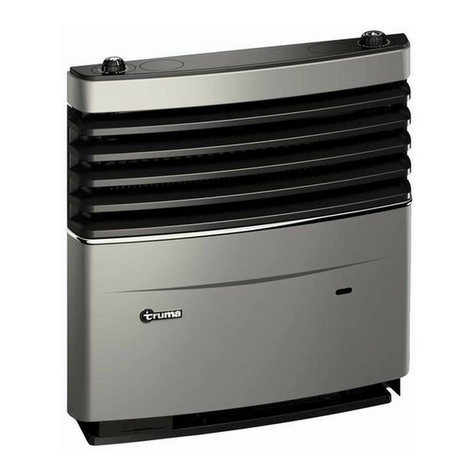
Truma
Truma Ultraheat S 3004 Operating instructions & installation instructions
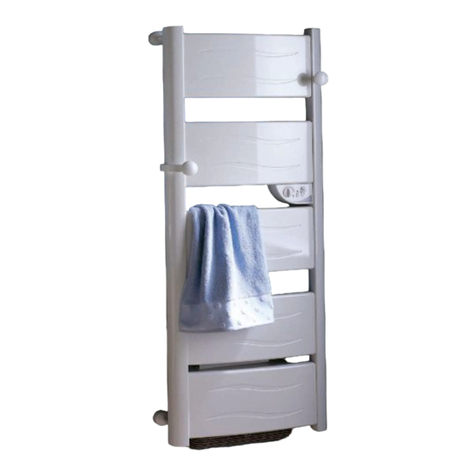
Atlantic
Atlantic Zanzibar Ventilo User and installation manual
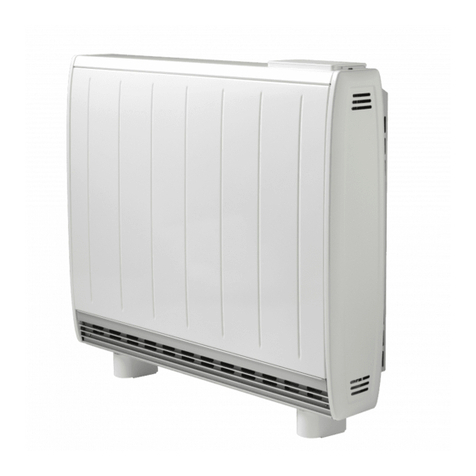
Dimplex
Dimplex Quantum quick start guide
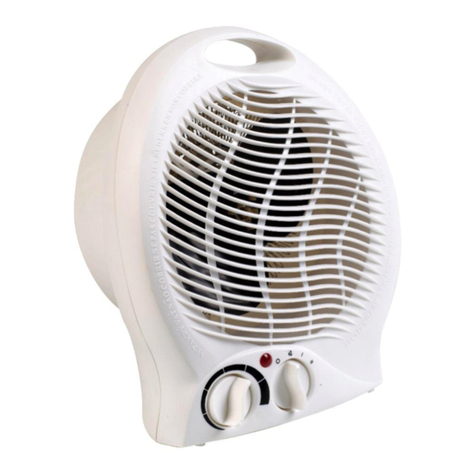
Toolland
Toolland TC78020 user manual

Thermogroupuk
Thermogroupuk ThermoRAIL 7081 installation guide
